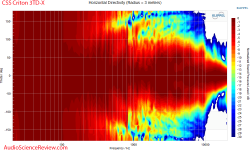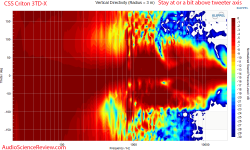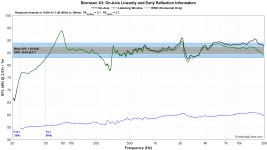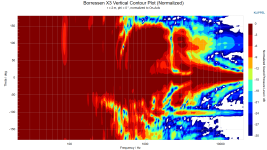This week appeared two reports of tower speakers, measurements done with Klippel NFS. Both show surpisingly loud response of 800Hz (midrange driver range) vertically at around 110deg which means on top of the tower! Speakers are 3-way with double woofers, but different layout of mid/tweeter. What the heck? Edge diffraction or panel resonance? Or artefact in NFS synthesis?
https://www.audiosciencereview.com/...ds/css-criton-3td-x-kit-speaker-review.58467/
the other is Erin's Audio Corner of Borresen X3 (in Patreon), not yet public.
The CSS has been measured also in anechoic chamber and response is different there, without ripples.
Borresen axial response is smoother at that region.






https://www.audiosciencereview.com/...ds/css-criton-3td-x-kit-speaker-review.58467/
the other is Erin's Audio Corner of Borresen X3 (in Patreon), not yet public.
The CSS has been measured also in anechoic chamber and response is different there, without ripples.
Borresen axial response is smoother at that region.






Sometimes you can turn up the volume, feel the box, and tell where it is vibrating (maybe on top?). If no vibration then what is left but the right conditions to launch a wave off of a surface?
I think it would be both Interesting and helpful to see and compare measurements from both Klippel and Anechoic of the same speaker
Check the borresen x3 at stereoplay:
https://www.stereo.de/testergebnis/borresen-x3-2332/
Not so fine in my view
https://www.stereo.de/testergebnis/borresen-x3-2332/
Not so fine in my view
A bit of everything, I would guess.Edge diffraction or panel resonance? Or artefact in NFS synthesis?
Actually not an NFS artefact but a common error of how data is displayed: directivity plots normalized to 0deg on-axis are fundamentally wrong for obvious reasons. Either don't normalize but if you do, normalize to the spatially averaged values (with directions weighted of course, for a reasonable listening window).
Further, the color coding used to show levels is not evenly spaced perception-wise, gray scale would be much more appropriate.
CSS speaker's non-NFS measurements are of axial response only

comparison with psychoacoustic smoothing

On-axis only response of CSS, with Klippel NFS

comparison with psychoacoustic smoothing
On-axis only response of CSS, with Klippel NFS
Last edited:
That Borresen response is rough.
The bass area of the frequency response looks very familiar as I'm working on 3 way project.
Here's my current model.


Now, with just a few tweaks to the woofer circuit.


Maybe the 4 small ports on the back account for the strange ripples in the bass region of the impedance.
The bass area of the frequency response looks very familiar as I'm working on 3 way project.
Here's my current model.
Now, with just a few tweaks to the woofer circuit.
Maybe the 4 small ports on the back account for the strange ripples in the bass region of the impedance.
Last edited:
To get right down to the point, these speakers are an excellent example of a marketing technique used by quite a few manufacturers these days. It basically focuses around a catchy design gimmick, justifying a ridiculously high asking price in order to excuse obvious poor acoustical performance as an intended (mis-)function.
When properly implemented, a very slight and shallow dip across the 3 - 4k midrange area can really help a speaker sound more natural and relaxed while only removing a very minute amount of midrange forwardness. To my (amateur and professional) ears, this is a worthwhile and welcome compromise, making a speaker more enjoyable and less fatiguing over long periods of listening.
Speakers measuring flat in FR usually don't sound that good to the average ear with most types of music. This is especially true at higher listening levels, when most people's hearing is more sensitive to the 3.5 k range. Designing a subtle dip into this area can be overall very beneficial in the real world. Unless you're dealing with a critical application (such as a studio monitor), it will only help in making a speaker more suited to listening to a wide variety of music. Everyone's ears are slightly different this way, but considering a broad range of taste you'll encounter, it will appeal to most listeners, especially at higher volume levels.
Don't get me wrong, I'm not at all defending this overpriced waste of otherwise excellent driver components represented here. You could likely produce a significantly better sounding set of speakers with the help of basic tried and true design guidelines using much lower priced components. It doesn't require much technical analysis to figure out what's wrong with these speakers.
When properly implemented, a very slight and shallow dip across the 3 - 4k midrange area can really help a speaker sound more natural and relaxed while only removing a very minute amount of midrange forwardness. To my (amateur and professional) ears, this is a worthwhile and welcome compromise, making a speaker more enjoyable and less fatiguing over long periods of listening.
Speakers measuring flat in FR usually don't sound that good to the average ear with most types of music. This is especially true at higher listening levels, when most people's hearing is more sensitive to the 3.5 k range. Designing a subtle dip into this area can be overall very beneficial in the real world. Unless you're dealing with a critical application (such as a studio monitor), it will only help in making a speaker more suited to listening to a wide variety of music. Everyone's ears are slightly different this way, but considering a broad range of taste you'll encounter, it will appeal to most listeners, especially at higher volume levels.
Don't get me wrong, I'm not at all defending this overpriced waste of otherwise excellent driver components represented here. You could likely produce a significantly better sounding set of speakers with the help of basic tried and true design guidelines using much lower priced components. It doesn't require much technical analysis to figure out what's wrong with these speakers.
Borresen is approaching Wilson and B&W level of overegineering and cost.
It would nice to know how they managed to make that vertical 100-120 deg singing...
Impedance and 60-80 Hz problems arise from the tall cab and mysterious vents. Erin's Patreon members ca see nearfields, and I bet soon they appear at his homepage.
It would nice to know how they managed to make that vertical 100-120 deg singing...
Impedance and 60-80 Hz problems arise from the tall cab and mysterious vents. Erin's Patreon members ca see nearfields, and I bet soon they appear at his homepage.
The typical dip in that area is usually a compensation for increased off axis output in that area. As such still a design flaw.
When I design a Fletcher Munson dip into a higher end speaker design, its in form of a selectable notch, but after starting with a flat base response with 3 steps of amplitude and center frequency choices to suit listener taste and unique hearing physiology. IOW, you get the curve you want, including the choice of a totally flat FR, both on and off axis.
In the event of using a permanent notch to compensate for bad engineering, its always going to sound bad at some immediate listening location. Significant vertical lobing is a common problem with many designs, regardless of anechoic or in room FR. The typical lower mid floor dip is the main thing needing compensation in the practical real world listening setting. The rest is down to the designer and his tastes, given the speaker in question is for casual listening.
Concentrating on driver quality as well as suitability for use in a specific design is by far more important than any other aspect with the enclosure design being on equal terms. You make a hard choice going with a traditional multi way / multi driver design, accepting all of its compromises while knowing you must work around all of them to produce a successfully decent sounding speaker. No amount of visually smooth and slick looking design work (mis)using the fanciest drivers is going to change the laws of physics or acoustics, in hopes of achieving an equally good sounding speaker. Some people still listen with their ears, so there always will be a sucker born who will purchase such a product.
Studio monitor worthy FR (on and off axis) isn't always necessary or preferred. The constant obsession with designing a flat speaker doesn't always result in a better sounding speaker in the practical real world.
In the event of using a permanent notch to compensate for bad engineering, its always going to sound bad at some immediate listening location. Significant vertical lobing is a common problem with many designs, regardless of anechoic or in room FR. The typical lower mid floor dip is the main thing needing compensation in the practical real world listening setting. The rest is down to the designer and his tastes, given the speaker in question is for casual listening.
Concentrating on driver quality as well as suitability for use in a specific design is by far more important than any other aspect with the enclosure design being on equal terms. You make a hard choice going with a traditional multi way / multi driver design, accepting all of its compromises while knowing you must work around all of them to produce a successfully decent sounding speaker. No amount of visually smooth and slick looking design work (mis)using the fanciest drivers is going to change the laws of physics or acoustics, in hopes of achieving an equally good sounding speaker. Some people still listen with their ears, so there always will be a sucker born who will purchase such a product.
Studio monitor worthy FR (on and off axis) isn't always necessary or preferred. The constant obsession with designing a flat speaker doesn't always result in a better sounding speaker in the practical real world.
800Hz is an interesting frequency range. It is whiny or nasal for male vocals, and the majority of output for womens' range. It is usually where fibrous or woven cones have increased distortion or flex. It is also where 8" woofers tend to have surround resonance issues. It also has a wavelength of about 16-18", and is not near as directional as tweeters go with a broad off axis response in drivers less than 10".
Therefore, approaching a point source or smaller woofer, say dual 7", and a 5.5" mid and 3" tweeter, and the layout such as the 3T, that puts the 800Hz wavelength right or exactly at the distance to the top of the cab. This is likely the reason for the ripple.
Therefore, approaching a point source or smaller woofer, say dual 7", and a 5.5" mid and 3" tweeter, and the layout such as the 3T, that puts the 800Hz wavelength right or exactly at the distance to the top of the cab. This is likely the reason for the ripple.
@wolf_teeth A surprising amount of resonances in the lower mids can be attributed to the spider design and cavity behind the dustcap through the pole piece. This plagues drivers with larger, stiffer constant wave spiders along with larger convex dustcaps.
The solution to most of those issues is to use the smallest possible dustcap, attaching it as close to the VC former / cone neck junction. Concave dustcaps have their issues too. The sharp corner formed at the cone attaching point can produce resonances from increased stress and flexing leverage, resulting in higher resonances past cone breakup. Its easier to deal with these, being out of the driver's main operating band.
Larger diameter spiders should be modified to have varying size waves throughout their diameter,, spreading the resonance out across a wider range with diminished amplitude. ScanSpeak uses this on some of their Revalator models as does Seas with great success.
Its very hard to get consistent lower midrange performance and smoothness on minimum baffle speakers with smaller LF drivers. If a wide horizontal dispersion is your preference, I'd use side mounted lower profile LF drivers to support bass instead of using many smaller drivers. This has other advantages as well with directivity when applied correctly.
The solution to most of those issues is to use the smallest possible dustcap, attaching it as close to the VC former / cone neck junction. Concave dustcaps have their issues too. The sharp corner formed at the cone attaching point can produce resonances from increased stress and flexing leverage, resulting in higher resonances past cone breakup. Its easier to deal with these, being out of the driver's main operating band.
Larger diameter spiders should be modified to have varying size waves throughout their diameter,, spreading the resonance out across a wider range with diminished amplitude. ScanSpeak uses this on some of their Revalator models as does Seas with great success.
Its very hard to get consistent lower midrange performance and smoothness on minimum baffle speakers with smaller LF drivers. If a wide horizontal dispersion is your preference, I'd use side mounted lower profile LF drivers to support bass instead of using many smaller drivers. This has other advantages as well with directivity when applied correctly.
For a good example of exactly what I'm talking about, look at Seas U18 and Audax carbon fiber midbasses. I am not speaking of spider issues.
Here's another floorstander that doesn't exhibit upfiring/Atmos-style ceiling speaker special FX:
https://www.audiosciencereview.com/forum/index.php?threads/revel-f328be-speaker-review.17443/
So it's probably not a NFS thing...
Note to self- use mass loaded deadening material internally at the top/bottom of cabinet, and avoid teeny tiny ports...
https://www.audiosciencereview.com/forum/index.php?threads/revel-f328be-speaker-review.17443/
So it's probably not a NFS thing...
Note to self- use mass loaded deadening material internally at the top/bottom of cabinet, and avoid teeny tiny ports...
- Home
- Loudspeakers
- Multi-Way
- What's goin' on - with NFS